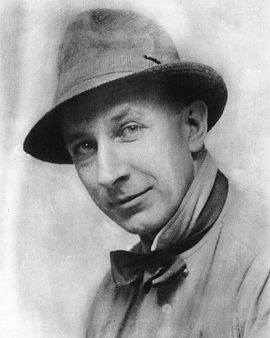George Wesley Bellows was an American painter and draughtsman who was strongly committed to social issues. He was born in Columbus, Ohio in 1882. Bellows was self-taught and discovered his love of drawing as a child. However, his passion for sports still prevailed in high school. Bellows was a gifted baseball and basketball player. After graduating from high school he played baseball in the semi-professional league. In 1901 Bellows enrolled at Ohio State University. Here he began to recall his artistic abilities: He created illustrations for the student newspaper and worked part-time as a commercial artist. Despite his talent for drawing and his success as a graphic artist, Bellows decided to concentrate on painting. Even before he graduated in Ohio, the ambitious young man was drawn to the big city of New York, which then, as now, was an excellent place for budding artists.
In the hip Manhattan district, Bellows met like-minded people, including the artist Robert Henri. Henri was professor of painting at the renowned New York School of Art. Robert Henri used a progressive, direct technique for his art, which was deliberately set apart from the classical academic art of previous years. His works boldly showed the everyday life of the simple American working class. Bellows was fascinated by Henri's understanding of art and his use of form and color. Influenced by Henri, Bellow developed a style that art historians later called American Realism. In New York Bellow also found inspiration during his numerous visits to the famous Metropolitan Museum of Art. In 1911 his favourite museum even acquired his work entitled "Up the Hudson". This honour made Bellow one of the youngest artists whose works were acquired by the influential institution.
In 1906 Bellow moved into his own studio. Two years later he participated in the exhibition initiated by Robert Henri called "The Eight". Bellow and the other seven artists in the exhibition protested against the strict and conservative guidelines of the National Academy of Design with their alternative show of works. Bellow's works and his social commitment to making the art world more just made him a star figure of the new cultural wave that wanted to create socially and politically charged art. Bellow worked with the socialist magazine "The Masses". He also criticized in a series of lithographs the invasion of Germany into Belgium and the role of the United States in the First World War.
In addition to his own work in the studio, Bellow taught at the Art Students League in New York and the Art Institution of Chicago and continued to participate actively in exhibitions. His most famous paintings and lithographs, despite his affinity for social issues, are his portraits of athletes, especially amateur boxers.
×





.jpg)
.jpg)
.jpg)
.jpg)
.jpg)
.jpg)
_-_(MeisterDrucke-1666158).jpg)
_-_(MeisterDrucke-1666158).jpg)
.jpg)
.jpg)
.jpg)
.jpg)
.jpg)
.jpg)
.jpg)
.jpg)
.jpg)
.jpg)
.jpg)
.jpg)
.jpg)
.jpg)
.jpg)
.jpg)
.jpg)
.jpg)
.jpg)
.jpg)
.jpg)
.jpg)
.jpg)
.jpg)
_-_(MeisterDrucke-1666139).jpg)
_-_(MeisterDrucke-1666139).jpg)
.jpg)
.jpg)
.jpg)
.jpg)
.jpg)
.jpg)
 - (MeisterDrucke-542719).jpg)
 - (MeisterDrucke-542719).jpg)
.jpg)
.jpg)
.jpg)
.jpg)
.jpg)
.jpg)
.jpg)
.jpg)
.jpg)
.jpg)
.jpg)
.jpg)
.jpg)
.jpg)
.jpg)
.jpg)
.jpg)
.jpg)
.jpg)
.jpg)
.jpg)
.jpg)
.jpg)
.jpg)
.jpg)
.jpg)
.jpg)
.jpg)
.jpg)
.jpg)
.jpg)
.jpg)
.jpg)
.jpg)
.jpg)
.jpg)
.jpg)
.jpg)
.jpg)
.jpg)
.jpg)
.jpg)
.jpg)
.jpg)
.jpg)
.jpg)
.jpg)
.jpg)
.jpg)
.jpg)
.jpg)
.jpg)
.jpg)
.jpg)
.jpg)
.jpg)
.jpg)
.jpg)
.jpg)
.jpg)
 - (MeisterDrucke-638295).jpg)
 - (MeisterDrucke-638295).jpg)
.jpg)
.jpg)
.jpg)
.jpg)
.jpg)
.jpg)
.jpg)
.jpg)
.jpg)
.jpg)
.jpg)
.jpg)
.jpg)
.jpg)
.jpg)
.jpg)
.jpg)
.jpg)
.jpg)
.jpg)
.jpg)
.jpg)
.jpg)
.jpg)
.jpg)
.jpg)
.jpg)
.jpg)
.jpg)
.jpg)
.jpg)
.jpg)
.jpg)
.jpg)
.jpg)
.jpg)
.jpg)
.jpg)
.jpg)
.jpg)
.jpg)
.jpg)
.jpg)
.jpg)
.jpg)
.jpg)
 - (MeisterDrucke-249977).jpg)
 - (MeisterDrucke-249977).jpg)
.jpg)
.jpg)
.jpg)
.jpg)
.jpg)
.jpg)
.jpg)
.jpg)
.jpg)
.jpg)
_-_(MeisterDrucke-1453218).jpg)
_-_(MeisterDrucke-1453218).jpg)
.jpg)
.jpg)
.jpg)
.jpg)
.jpg)
.jpg)
 1916 - (MeisterDrucke-164730).jpg)
 1916 - (MeisterDrucke-164730).jpg)
.jpg)
.jpg)
.jpg)
.jpg)
.jpg)
.jpg)
.jpg)
.jpg)
_-_(MeisterDrucke-638183).jpg)
_-_(MeisterDrucke-638183).jpg)
.jpg)
.jpg)
.jpg)
.jpg)
.jpg)
.jpg)
.jpg)
.jpg)
.jpg)
.jpg)
.jpg)
.jpg)
.jpg)
.jpg)
.jpg)
.jpg)
.jpg)
.jpg)






